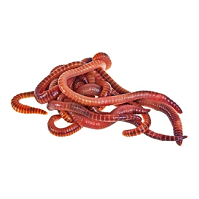Top-quality red worms: For organic waste solutions
Everything You Need to Know Regarding Red Wigglers for Composting
Red wigglers, or Eisenia fetida, play a pivotal role in the world of composting, transforming organic waste right into useful soil amendments. The procedure of setting up a worm bin and keeping it can present challenges.
What Are Red Wigglers?

(red wiggler earthworms for sale)
Belonging To The United States and copyright, red wigglers are surface-dwelling microorganisms that like damp, warm habitats abundant in decaying raw material. Their diet plan consists mainly of decaying plant product, food scraps, and various other natural debris, which they consume and damage down effectively. As they digest this product, they generate nutrient-rich castings that improve dirt fertility.
Red wigglers are hermaphroditic, having both male and female reproductive organs, and can replicate promptly under optimal conditions. On the whole, red wigglers are essential factors to the process of reusing organic waste into important compost.
Advantages of Making Use Of Red Wigglers
Utilizing red wigglers in composting systems supplies various advantages that boost both the performance of waste administration and the high quality of the resulting compost. These worms, medically known as Eisenia fetida, are specifically reliable at damaging down raw material, turning kitchen scraps and lawn waste into nutrient-rich compost at an increased price.
Among the key advantages of utilizing red wigglers is their capacity to take in big quantities of organic product, often processing their weight in food waste daily. This high intake rate brings about faster disintegration and reduces the volume of waste sent to land fills. In addition, the castings created by red wigglers are rich in vital nutrients, useful microorganisms, and enzymes, making them an outstanding plant food for yards and plants.
Additionally, red wigglers thrive in a range of atmospheres, making them versatile for both indoor and exterior composting systems - red wigglers. Their existence in a compost bin assists to aerate the product, stopping odors and advertising a healthy composting procedure. In general, utilizing red wigglers not just adds to efficient waste management but additionally sustains sustainable gardening techniques through the manufacturing of top quality garden compost
(Lake James Worms)
Setting Up Your Worm Container
To efficiently establish a worm bin, it is important to pick a suitable container that satisfies the needs of red wigglers while providing a favorable environment for composting. An appropriate bin can be made from plastic, wood, or steel, with a capability of a minimum of 1 square foot for every pound of worms.
Make certain the container has ample drainage holes to avoid excess moisture, as red wigglers flourish in a wet, however not water logged, setting. red wigglers. The container should additionally be aerated to provide sufficient airflow, preventing anaerobic problems that can damage the worms
A perfect place for the worm container is a cool, dark location, cost-free from straight sunshine and extreme temperatures, as red wigglers prefer a temperature level series of 55 to 77 levels Fahrenheit.
Before introducing the worms, prepare bed linens products such as shredded newspaper, cardboard, or coconut coir, which will provide both go to this website environment and food. Moisten the bedding gently to develop a welcoming environment for the worms. Last but not least, take into consideration putting a lid on the container to preserve moisture and lower pests, while guaranteeing it can be quickly removed for maintenance.
Feeding and Care Standards
Feeding red wigglers is a critical element of maintaining a healthy composting system. These worms thrive on a varied diet, largely composed of natural materials such as fruit and veggie scraps, coffee grounds, and smashed eggshells. It is vital to avoid feeding them meat, dairy products, and oily foods, as these can create undesirable smells and draw in parasites.
When introducing food to your worm container, chop or shred products into smaller sized pieces to help with quicker decomposition. Start with percentages to gauge the worms' consumption price, slowly raising the amount as they adjust. It is suggested to alternating feeding areas within the container to encourage detailed mixing and aeration of the garden compost.

Troubleshooting Common Issues
Maintaining a prospering worm composting system can sometimes offer obstacles that need interest and troubleshooting. Typical problems include an unpleasant smell, which often indicates overfeeding or the presence of anaerobic problems. To remedy this, decrease the amount of food included and make certain appropriate oygenation by blending the bedding product.
An additional frequent issue is the getaway of worms from the container. This can occur because of extreme dampness or unsuitable environmental conditions. Consistently check the moisture levels, intending for a moist but not soggy uniformity, and maintain optimum temperatures between 60-80 ° F(15-27 ° C )to produce a comfortable environment for your red wigglers.
Bugs, such as fruit flies, can additionally invade worm containers. red wigglers. To combat this, cover food scraps with a layer of bed linens or shredded paper to deter flies from laying eggs. In addition, ensure that any food included is fresh and free from mold and mildew, which can attract unwanted insects
Lastly, if your worms seem non-active, look for stress and anxiety elements such as temperature level fluctuations or insufficient dampness. Addressing these usual concerns will certainly aid keep a healthy and balanced and productive worm composting system.
Verdict
In recap, red wigglers, or Eisenia fetida, play a vital role in lasting waste administration through vermicomposting. Correct configuration and upkeep of a worm container, along with adherence to feeding standards, make sure a growing environment that decreases land fill payments.